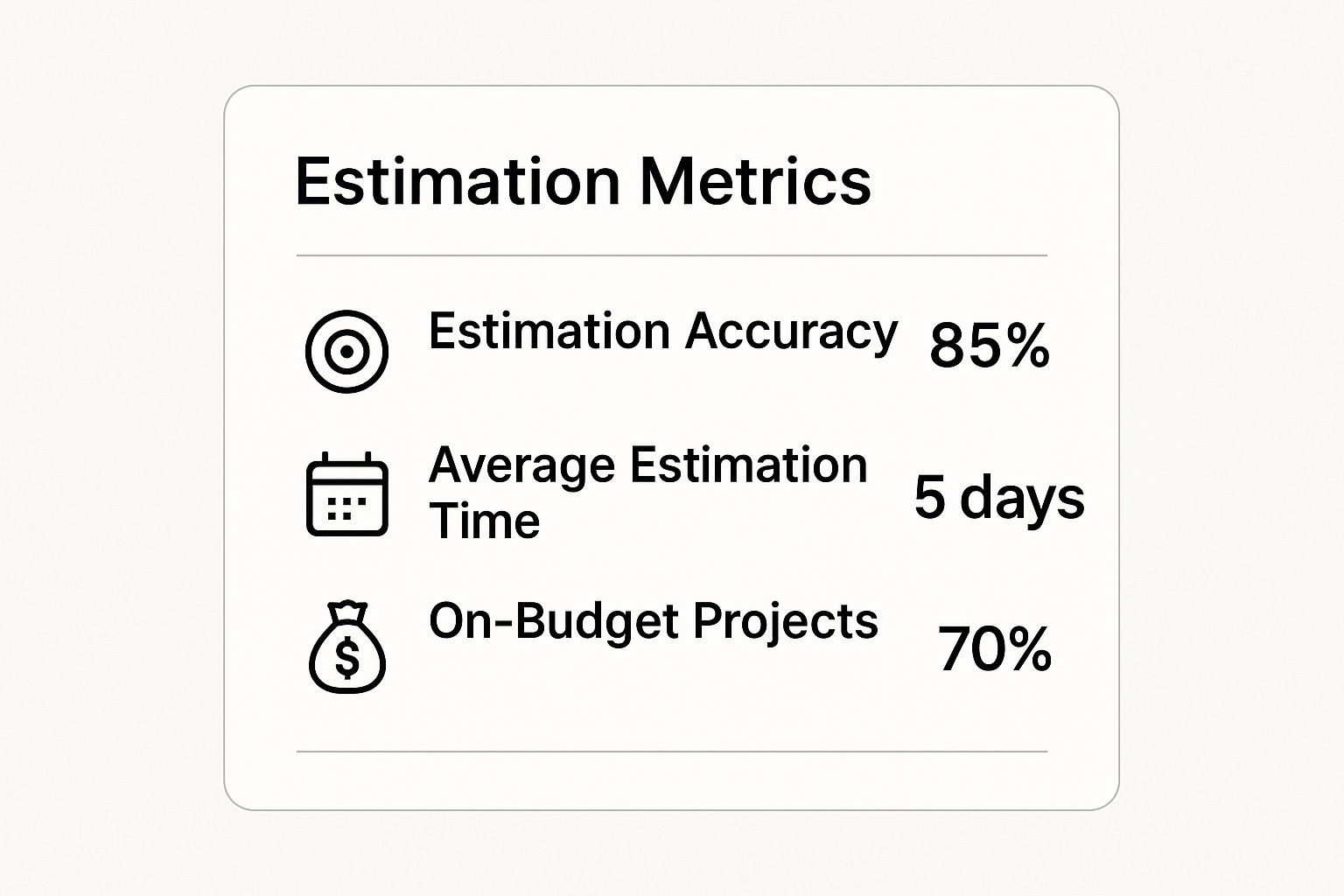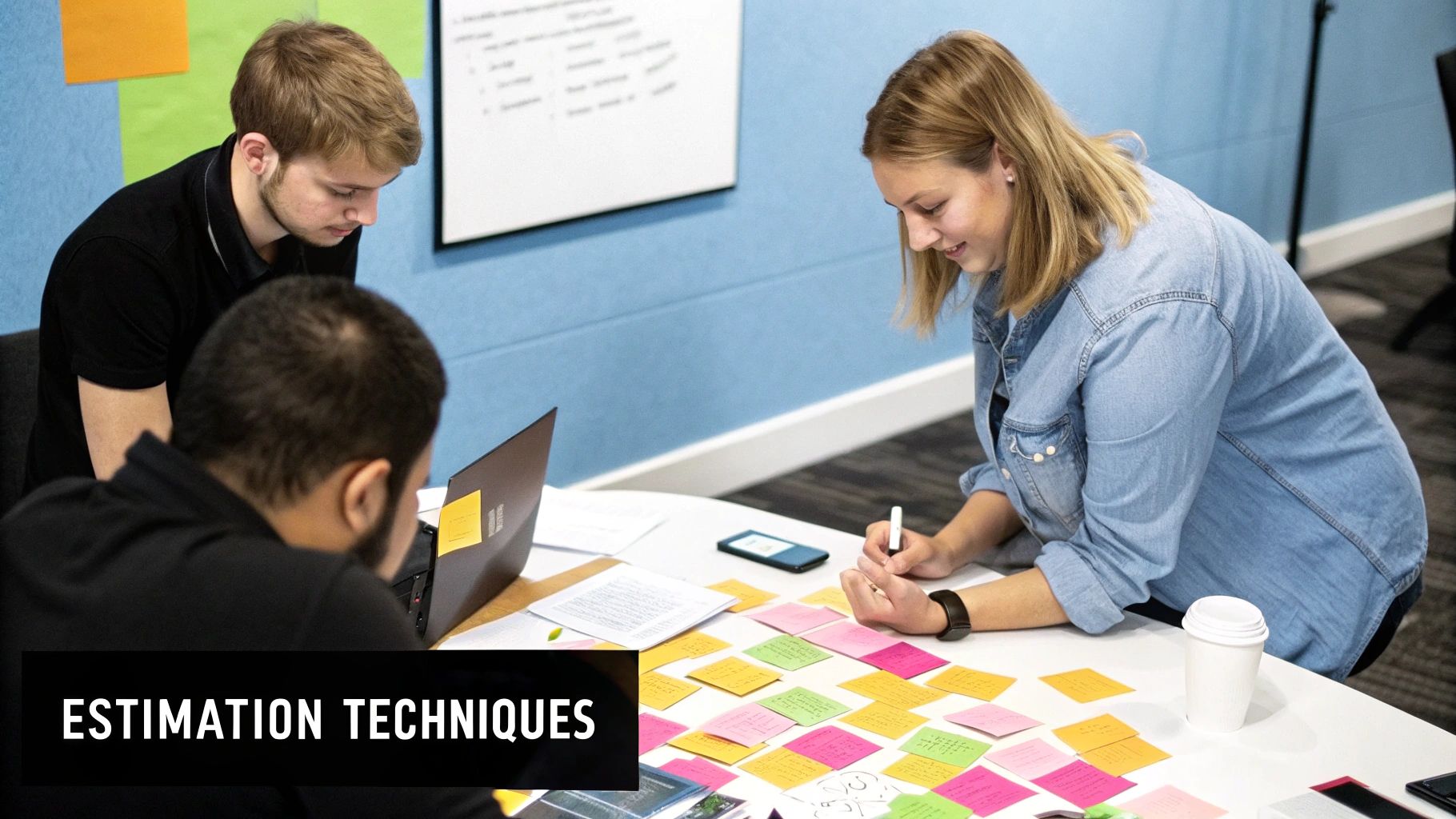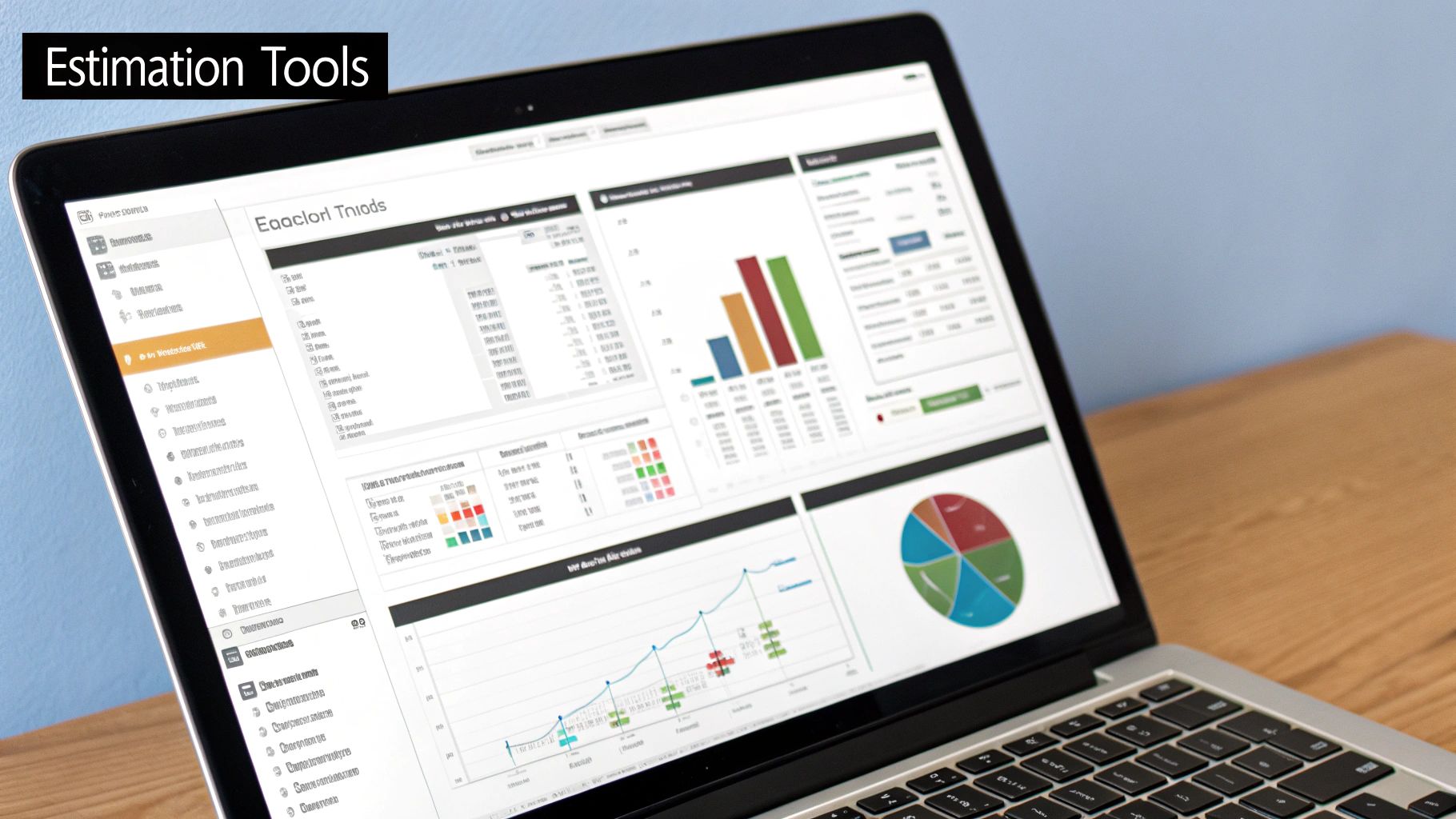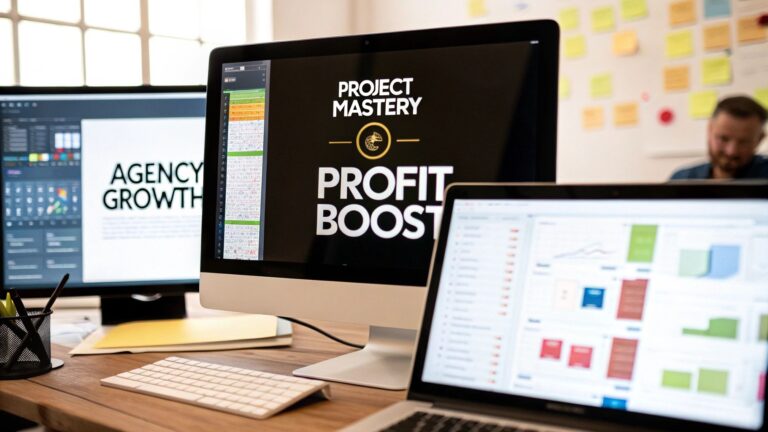Estimating Software Project Timelines: Proven Techniques
When you boil it down, estimating a software project is all about forecasting the time, effort, and money needed to get the job done. It’s a bit of an art and a science, really. You’re pulling from past projects, leaning on expert gut feelings, and using proven techniques to make an educated guess in a world full of unknowns.
Getting this part right is the bedrock of any successful project.
Why Accurate Project Estimation Matters

Spot-on estimation isn't just about meeting a deadline. It's about creating a development process that's sustainable, predictable, and trustworthy. When your forecasts are solid, everyone wins—teams feel empowered, stakeholders know what to expect, and budgets stay intact.
Think of a good estimate as a communication tool. It clearly tells a client what’s coming and gives developers a realistic target to aim for. A bad estimate, on the other hand, kicks off a domino effect of chaos. You’re looking at missed deadlines, blown budgets, and a team that’s completely demoralized. It turns a creative partnership into a high-stress scramble against an impossible clock.
The Foundation of Strategic Success
Precise forecasting helps companies make smarter decisions at a higher level. When leaders have a clear view of what a project will actually take, they can prioritize initiatives, assign budgets that make sense, and make sure the dev work lines up with the company's big-picture goals.
This is more important than ever. The global software developer community is growing to nearly 28.7 million people, and the market for project management software is on track to hit $12.02 billion by 2030. Yet, a surprising 55% of organizations don’t have access to real-time project KPIs, which shows a major disconnect in their ability to estimate and track progress. You can dive deeper into these project management statistics to see the full picture.
A project without a solid estimate is like a ship without a rudder. You might be moving, but you have no control over where you’ll end up or when you’ll get there.
Building Trust and Preventing Burnout
At the end of the day, the goal of a good estimate is to set everyone up for success. For stakeholders, that means transparency and predictability. For the development team, it means having goals they can actually hit, which prevents burnout and creates a real sense of accomplishment.
A well-crafted estimate delivers some serious benefits:
- Improved Client Relationships: Realistic timelines build trust from day one and help you avoid those awkward "we're behind schedule" conversations later.
- Enhanced Team Morale: Developers thrive when they have clear, attainable targets. It empowers them to do their best work.
- Better Budget Control: Accurate forecasts are your best defense against scope creep and going over budget.
This guide will walk you through the frameworks and techniques you need to stop guessing and start forecasting with confidence.
Choosing Your Estimation Framework
Getting your software project estimation right starts with one critical choice: the framework. This isn't just about picking a formula; it's about deciding how your team will talk about and agree on the work ahead. There’s no single "best" framework—the right one is simply the one that fits the reality of your project.
For massive projects where the requirements are locked down and well-understood, algorithmic models like the Constructive Cost Model (COCOMO) are fantastic. These frameworks are all about the data. They take historical project information, lines of code, and complexity ratings to spit out a quantitative estimate. It brings a scientific feel to the process, which is exactly what you need when precision is everything.
But what about projects where things are constantly changing? For most teams working in an Agile world, a collaborative approach is a much better fit. Techniques like Planning Poker are designed to embrace uncertainty. Instead of relying on a formula, they lean on the collective wisdom and gut feeling of the development team to land on an estimate, usually in story points rather than concrete hours.
Algorithmic Precision vs. Collaborative Insight
Think of it this way. Algorithmic models are perfect when you have a ton of historical data and the new project is a lot like things you've done before. Let's say you’re building another standard e-commerce site for a client, and it’s the sixth one you've done this year. COCOMO can look at the scope, compare it to past work, and give you a statistically solid forecast. This is a lifesaver for fixed-bid contracts.
Now, flip the script. Imagine you’re building a completely new AI feature that no one on your team has ever touched. An algorithm is useless here; it has no data to work with. This is where your team's brainpower becomes your best asset. Planning Poker gets everyone talking, debating complexities, and calling out risks no one else saw. It’s not just about getting a number; it's about building a shared understanding and getting team buy-in. You can see how these different approaches fit into the bigger picture by exploring project management in Waterfall vs Agile.

As these numbers show, while perfect accuracy is a myth, having a structured way of estimating dramatically boosts your chances of staying on budget.
Matching the Framework to Your Project Context
The final call really boils down to your project’s environment. How big is it? How is the team set up? How much do you not know? Forcing an agile technique like Planning Poker on a rigid, large-scale government contract is a recipe for chaos. By the same token, trying to apply a strict algorithmic model to a fast-moving startup will just slow everyone down.
Let's be honest, estimation is one of the hardest parts of our job. Studies show a pretty even split in the techniques people use, with methods like COCOMO, Wideband Delphi, and Planning Poker each accounting for about 25% of approaches. It all comes down to a trade-off: data-driven models give you quantitative precision, while collaborative methods give you flexibility and help get the whole team on the same page.
The best estimation framework doesn’t just give you a number; it provides a shared understanding of the work ahead. It aligns the team and stakeholders around a realistic, defensible forecast.
To help you find the right fit, it’s useful to see how the most common frameworks stack up against each other.
Comparison of Key Software Estimation Frameworks
This table breaks down the most popular estimation methodologies, giving you a quick look at where each one shines and where it might fall short.
| Framework | Best For | Key Benefit | Main Drawback |
|---|---|---|---|
| COCOMO | Large, well-defined projects with historical data. | Provides objective, data-driven, and repeatable estimates. | Inflexible and less accurate for novel or small projects. |
| Planning Poker | Agile teams working on projects with evolving requirements. | Fosters team collaboration, shared ownership, and uncovers risks. | Can be subjective and time-consuming for large backlogs. |
| Wideband Delphi | Projects with high uncertainty that require expert judgment. | Anonymity reduces bias and encourages honest expert input. | Relies heavily on the availability and expertise of participants. |
| Function Point | Business systems where functionality is the primary cost driver. | Independent of technology and can be used early in the lifecycle. | Complex to calculate and requires specialized training. |
Ultimately, choosing a framework is about being realistic about your project, your team, and your goals. The right choice will make the entire estimation process smoother and the results far more reliable.
Putting Core Estimation Techniques to Work

Once you have a framework in mind, it’s time to get your hands dirty with the actual techniques that turn project scope into a tangible estimate. These are the tools you'll use day-to-day. The real trick is knowing which one to pull out of your toolbox at the right time, depending on how much (or how little) you know about the project.
When you're at the very start and details are fuzzy, Top-Down (Analogous) Estimation is your go-to. Honestly, it's a bit like a gut check. You look at the proposed project and think, "You know, this feels a lot like that big e-commerce build we did last year."
It’s quick. It requires almost no detailed specs. This makes it perfect for giving stakeholders those early, ballpark figures they always ask for. If a similar mobile app took your team six months last time, you can pencil in six months for this new one as a starting point. The big catch? Hidden complexities—the dreaded "unknown unknowns"—can easily blow these early guesses out of the water.
Getting Down in the Weeds With Bottom-Up Estimation
As requirements start coming into focus, you can flip the script and use Bottom-Up Estimation. This is where the real accuracy lives, but it comes at a cost: your time. It’s all about breaking the project down into the smallest, most granular tasks imaginable and estimating each one.
You add up all those tiny estimates to get your grand total. This forces you and your team to think through every single piece of the puzzle, from a specific API endpoint to the padding on a button.
This level of detail is a natural fit for agile teams. In fact, as you begin documenting requirements in Agile, you’re already creating the user stories that are the perfect building blocks for a bottom-up estimate.
Let's take a simple user story: "As a user, I want to log in with my email and password." A bottom-up breakdown would look something like this:
- Build the login UI form (2 hours)
- Implement front-end validation (3 hours)
- Develop the backend authentication API (5 hours)
- Write the necessary integration tests (4 hours)
- Perform manual QA and sign-off (2 hours)
Suddenly, that one little story adds up to 16 hours of real work. By doing this for every single story, you assemble a project timeline that’s not just a guess, but a detailed, defensible plan.
The real magic of Bottom-Up Estimation isn't the number you get at the end. It's the deep, shared understanding of the work that it forces the entire team to develop.
Using Data and Embracing Uncertainty
Another really effective method, especially for mature teams, is Parametric Estimation. This is where you use your own historical data to build a statistical model. You identify a key "unit of work" and apply it to the new project. For example, if you know from past projects that building a standard data-entry screen takes your team an average of 12 hours, and the new app needs 10 of them, you can parametrically estimate 120 hours for that chunk of work.
But let's be real—no single number is ever the whole truth. That’s why Three-Point Estimation is so valuable. Instead of giving one estimate, you provide a range that reflects reality:
- Optimistic (O): The best-case scenario. The sun is shining, the code compiles on the first try, and no one gets sick.
- Most Likely (M): Your realistic, experience-based guess. This is what you actually think will happen.
- Pessimistic (P): The worst-case scenario. Murphy's Law is in full effect, and every possible roadblock appears.
You can then use a formula—either a simple average (O + M + P) / 3 or a weighted one like the PERT formula (O + 4M + P) / 6—to find a more probable outcome. This simple change moves the conversation away from the fiction of a single, perfect number and toward an honest discussion about risk and uncertainty.
Navigating Uncertainty and Common Pitfalls
Even the most meticulous estimate can crumble on contact with reality. Let's be honest: when we estimate a software project, we're not just predicting effort—we're trying to manage pure, unadulterated uncertainty. This is where so many teams get tripped up. It’s not that their techniques are bad, but they completely miss the hidden statistical traps and psychological biases that can turn a confident timeline into a series of missed deadlines.
A common mistake I see is teams simply adding up their individual task estimates to get a final number. This almost always leads to a dangerously optimistic schedule. The reason is a bit counterintuitive but absolutely critical for anyone leading a project. While a few tasks might finish early, the delays on others tend to have a much bigger, non-linear impact that throws the entire timeline off course. All it takes is one unexpectedly gnarly task to create a ripple effect of delays.
The Statistical Trap of Optimism
When you dig into the statistics of project timelines, you find that the average (mean) completion time is way more important than the most likely (median) time. When you sum up a series of tasks, only the averages add up in a straight line. Tasks with high uncertainty are the real schedule-killers; they have an outsized ability to inflate the entire project timeline. If you're into the math behind this, Erik Bernhardsson wrote a fantastic piece explaining this with a statistical model of project timelines.
This chart from his article shows it perfectly. It illustrates how just one task with a wide range of possible outcomes can dramatically skew the total project forecast.

Look at how the final distribution is much wider and pushed further to the right. It’s a clear visual of how uncertainty, not just effort, dictates your real-world delivery date.
Counteracting Human Bias in Estimation
Beyond the hard math, our own brains are often our worst enemies. We're all susceptible to cognitive biases that consistently push us toward underestimation. Just knowing they exist is the first step to fighting back.
Two of the biggest culprits in software estimation are:
- Anchoring Bias: This is when we get stuck on the first piece of information we hear. If a stakeholder casually says, "Oh, that sounds like a two-week job," that number can unconsciously "anchor" the team's thinking, even if a proper analysis shows it's wildly unrealistic.
- Optimism Bias: We're builders. We want to believe things will go well. So, we tend to estimate the "happy path" where every API call works on the first try and no unexpected bugs appear. We forget to account for the messy reality of development.
The most dangerous estimate you can give is a single number. It creates a false sense of certainty and leaves zero room for the "unknown unknowns" that pop up in every single project.
The best way to combat these biases is to change the conversation entirely. Stop giving single-point estimates. Seriously. From now on, always provide a range. Saying, "We're forecasting this feature to take between 3 and 5 weeks," immediately signals there's uncertainty involved and sets far more realistic expectations.
You should also make risk assessment a formal part of your estimation process. I recommend building a simple "risk register"—just a list of things that could go wrong. What if that third-party API is flaky? What if your lead developer is out sick for a week? By thinking through these scenarios ahead of time, you can build intelligent buffers into your timeline. Your estimate transforms from a hopeful guess into a resilient forecast.
Modern Tools and Best Practices
While frameworks give you a blueprint, modern estimation really runs on smart tools and battle-tested processes. The right tech stack can turn estimation from a dreaded chore into a powerful forecasting engine, pulling from past projects to make every new forecast sharper than the last.
Tools like Jira or Azure DevOps are central here. They do more than just track tasks—they create a rich database of your team's actual velocity and cycle times. Set them up right, and you'll get burn-down charts and reports that give you a data-backed picture of what your team can actually deliver, moving you far away from simple guesswork.
Adopting a Culture of Continuous Estimation
But tools are only half the battle. Your process is what makes it all work. I’ve found that the most successful teams treat estimation not as a one-time event but as an ongoing conversation. That means getting the entire development team involved, because their on-the-ground insights are pure gold.
Newer tools are also changing the game. For instance, code generation AI can fundamentally alter how we quantify and estimate development effort. Many teams are also looking into the best AI tools for project management to automate reporting and flag potential bottlenecks before they derail a sprint. Adopting this kind of tech helps you refine forecasts with real-time data.
The goal isn't just to produce a number. It's to create a shared understanding of the work, the risks, and the path forward. This collaborative approach builds accountability and ownership across the entire team.
For this to really stick, you need to bake a few best practices into your team's DNA:
-
Deconstruct Ruthlessly: Break down large epics and features into the smallest possible, well-defined user stories. A small, clear task is infinitely easier to estimate accurately than a big, vague one. Trust me on this.
-
Embrace the Cone of Uncertainty: Be upfront that early estimates are low-confidence forecasts. It's just the reality of software development. As the project moves forward and you learn more, your estimates will naturally become more precise. Always use ranges to reflect this.
-
Review and Retrospect: After each sprint or project, compare your estimates to the actual time spent. This isn't about pointing fingers. It’s a learning opportunity to spot patterns and improve your collective estimation skills for the next cycle.
Frequently Asked Questions About Software Estimation
Even after you've picked the right frameworks and tools, some tough questions always seem to pop up during software estimation. Let's be honest, these recurring challenges can make forecasting feel more like a shot in the dark than a disciplined process.
Here’s how to tackle some of the most common issues with clear, actionable advice from the trenches.
How Can I Improve Estimates With an Inexperienced Team?
When you’re working with a newer team, you have to lean heavily on collaborative and relative estimation techniques. Don't just hand down tasks and ask for a number.
Something like Planning Poker is perfect for this situation. It forces a conversation about complexity, which is invaluable. It’s during these discussions that junior developers learn from seniors, and hidden risks get dragged into the light. The process itself becomes a fantastic training tool.
The real key here is to break everything down. And I mean everything. A one-day task is infinitely easier to estimate accurately than a two-week epic. From the very first sprint, start tracking your estimates against the actual time it took. This practice builds a crucial historical dataset you can use for analogous estimates down the road, helping the team see where they were off and sharpen their skills over time.
One of the biggest mistakes I see is teams only estimating the "happy path"—the time it takes to write the code if everything goes perfectly. A real-world estimate must account for everything else: sprint planning, daily stand-ups, code reviews, testing, bug fixing, and deployment.
What Is the Best Way to Explain Estimates to Stakeholders?
First, stop giving a single number. Never say, "This will take exactly four weeks." It sets you up for failure.
Instead, always communicate a range. "Based on what we know right now, our forecast is between four and six weeks." This simple change immediately and honestly conveys the uncertainty that's just part of software development.
You need to frame your estimates as forecasts, not promises carved in stone. Explain that they will get more precise as the project moves forward and the team resolves more unknowns. To make this click for non-technical stakeholders, I like to use relatable analogies. Compare building a new feature to a home renovation—you might plan to just replace the cabinets, but once you open the wall, you could discover faulty plumbing that needs to be fixed. Unexpected things happen.
Visuals are your best friend here. A simple burn-down chart is a fantastic tool for showing progress against your projections. It builds trust by making the process transparent.
Should Our Estimates Include Time for Meetings and Bug Fixes?
Absolutely. A thousand times yes. A realistic estimate has to account for all project-related work. This is completely non-negotiable if you want any shot at accuracy.
So, how do you actually do it?
Many agile teams handle this by figuring out their true capacity. For instance, a team might learn from experience that about 20% of their time gets eaten up by non-feature work like meetings, company-wide events, and other administrative tasks. They then build this buffer right into their sprint planning from the start.
By making this overhead explicit, you create timelines that are far more reliable and trustworthy.
At MakeAutomation, we specialize in implementing the systems and processes that turn chaotic project management into something predictable and scalable. If you're ready to move beyond guesswork and build a foundation for reliable delivery, we can help. Learn how we optimize workflows for B2B and SaaS businesses.







